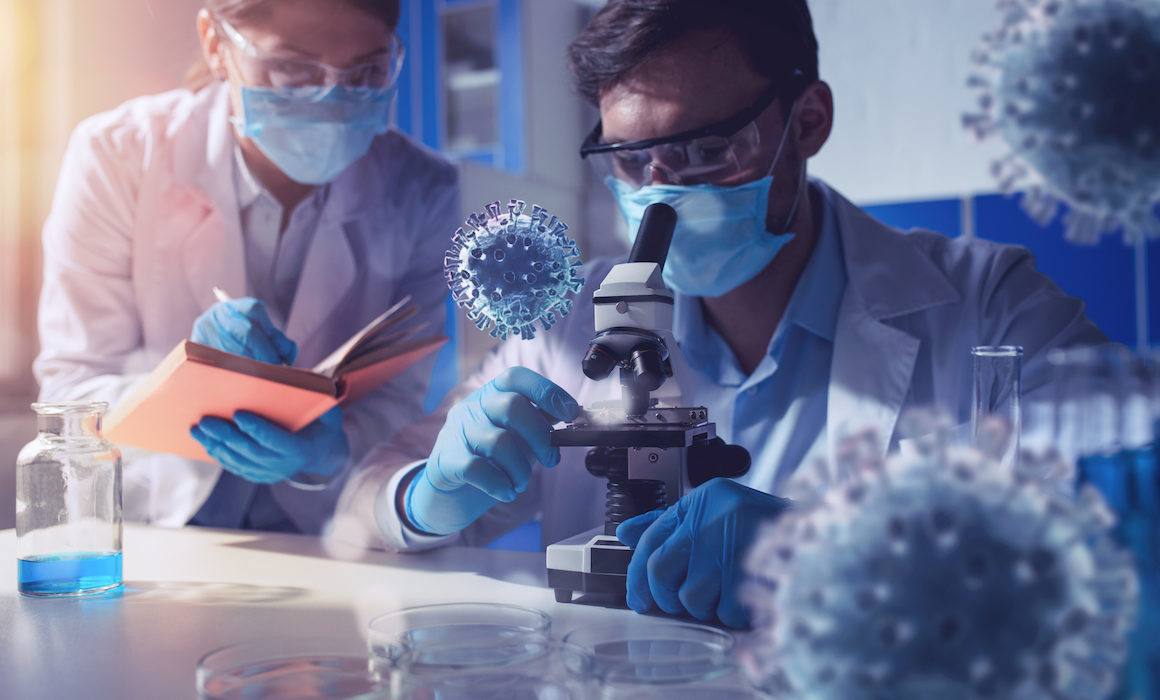As we enter the third year of the pandemic, we’d all love to think that the next mask we wear will be for Purim. But while herd immunity isn’t around the corner, plenty of good news is coming out of coronavirus research.
Scientists got a jump on developing mRNA vaccines, treatment for viruses moved quickly past Tamiflu, and researchers realized the critical importance of making findings available to the public. These were just some of the conclusions to come out of a recent Live From Technion webinar moderated by Professor Roy Kishony, the Marilyn and Henry Taub Professor of Life Sciences in the Technion Faculty of Biology. Stressing the importance of an interdisciplinary approach in tackling COVID-19, Prof. Kishony called on M.D.-Ph.D. candidate Matan Levine, mathematician Associate Professor Nir Gavish, and biomedical data scientist Assistant Professor Dvir Aran to address the impact of Israel’s vaccine campaigns, opportunities of using real-time data to make predictions, and lessons learned.
Israel was the first to vaccinate — reaching a 50% rate of adults by spring 2021 as compared with 15%-20% elsewhere — and first to give the second and third boosters. Israel has also been a leader in tracking vaccine data, hospitalizations, and deaths, and comparing them within different demographics. “This has been very special to Israel, and why you’ve seen so many important studies coming from here,” said Prof. Kishony. “All eyes are on us to see the impact of the vaccines on the disease.”
From the outset, Technion researchers were on the frontier of coronavirus detection — developing one of the earliest home test kits, and launching a project to expedite diagnosis by pooling test samples. Technion scientists then moved to COVID-19 protection, inventing personal protective equipment including the “Maya” covering for surgical masks to enhance safety for frontline workers. Now, the Technion is at the forefront of data research and analysis to understand both the effectiveness of vaccines and boosters on individuals and communities, and their waning protection over time.
Collaborating with Maccabi Healthcare Services, “we saw a reduction in the viral load just 12 days after the first vaccine shot, and a reduction in infections among vaccinated people,” said doctoral candidate Levine, who works in Prof. Kishony’s lab. “It was wonderful. But this was not the end of the story.” Continuing to run the data, they saw vaccine protection disappear after six months. As to whether we’ll need to be vaccinated every six months, Prof. Kishony foresees a scenario in which scientists will study emerging variants and tailor vaccines to protect against the new strains, as is done each year for the flu.
Prof. Gavish talked about his work in retrospective analysis, which he hopes will give scientists a leg up on managing future pandemics. “What would have happened if we had modified the booster campaign?” he asked. Hospitals would have been overwhelmed had the vaccine stayed restricted to people 60 years and older, he said, noting that Israel and other countries made the correct choice in opening the vaccines to younger adults. On the other end of the age spectrum, Israel might have seen a 20% decrease in COVID-19 cases among children five through 11 years old had the vaccine been open to them before the Delta surge, he said.
Prof. Aran, whose main research focus is cancer genomics, immunology, and precision medicine, delved in COVID-19 research and built a following on social media sharing his research widely on Twitter. He was among the first to use public data to show the vaccine’s effectiveness and its indirect protection for the community, meaning vaccinated individuals make the community safer for everyone. “If the people around me are vaccinated, it will be harder for the virus to spread even among unvaccinated people.”
Prof. Aran has been researching the causes of the vaccine’s waning effectiveness, and most recently has been focusing on Omicron. Vaccines aren’t stopping the spread of Omicron, but importantly, “they are providing protection against severe cases,” he said. Prof. Aran is not optimistic about achieving herd immunity. “We shouldn’t think, ‘let everybody get infected and we’ll get over it and move on with our lives.’ That’s not going to happen.” But he does see a silver lining to the dark COVID-19 clouds overhead.
“Since the start of the pandemic we’ve seen an arms race between humans and the virus,” he said. The people are pulling ahead, Prof. Aran concluded, ticking off some achievements that will position the world to fight off diseases in the future.
- Boosting Data Science: “Israel’s Ministry of Health now has data scientists. Who would have thought that two years ago? This pandemic has pushed data science forward many years.”
- Testing: “We now have rapid testing technologies and they’re getting better and better. There will be more technologies, not just for COVID-19 but for the flu and other diseases. COVID-19 has pushed us far into the future regarding diagnosing ourselves at home.”
- Improved Vaccines: “We thought that mRNA vaccines wouldn’t happen before 2030 or 2040. Now, we have four mRNA vaccines. The technology can be used for other diseases. We’re going to see clinical trials soon for curing cancer with mRNA vaccines.”
- Improved medications: “Nobody thought before to treat viruses. There was just Tamiflu. The developments (in medications) make me very optimistic.”
The pandemic has brought us together around urgent issues that affect us all. Most of us have known or cared for family and friends who have become ill with COVID-19. We have stood together in long lines to get tested, trying our best to keep ourselves and the community safe. We have applauded the selfless frontline workers who risked their health to treat others. And we’ve shared resources and information. “Twitter has allowed scientists to communicate with the public and to interact with other prominent scientists,” said Prof. Aran. “It is so important when everything changes every day to share science in real-time. I hope these tools remain, and COVID ends in the near future.”


